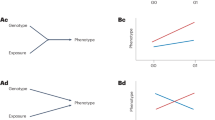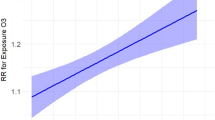Abstract
Owing to its carcinogenic properties, benzene is one of the most important environmental air pollutants. We have applied a simple pharmacokinetic model to estimate the individual daily exposure of persons of the general population to benzene using their urinary excretion of S-phenylmercapturic acid as biomarker of exposure. On the basis of a non-representative convenience sample of the general population, spontaneous urine samples of 43 non-smoking persons, 13 persons with exposure to environmental tobacco smoke (ETS) (as determined by urinary cotinine) and 72 smokers were analyzed for S-phenylmercapturic acid, and benzene exposure was back calculated on the basis of the results. The pharmacokinetic model was based either on estimated daily urinary volume or creatinine excretion. Median daily exposure of non-smokers was calculated to be 47 μg/day (volume-based model) and 63 μg benzene/day (creatinine-based model). ETS-exposed persons had a slightly higher median daily exposure of 65 μg/day (volume-based model) and 72 μg benzene/day (creatinine-based model). The daily exposure of smokers was significantly higher with median values of 491 μg benzene/day (volume-based model) and 693 μg benzene/day (creatinine-based model). Our biomarker-based model gave plausible results for daily benzene exposure that were in good agreement with exposure estimations published earlier. As it is purely based on the determination of individual internal dose, our model provides a powerful tool for the risk assessment of environmental benzene.
This is a preview of subscription content, access via your institution
Access options
Subscribe to this journal
Receive 6 print issues and online access
$259.00 per year
only $43.17 per issue
Buy this article
- Purchase on Springer Link
- Instant access to full article PDF
Prices may be subject to local taxes which are calculated during checkout



Similar content being viewed by others
References
Becker K., Conrad A., Kirsch N., Kolossa-Gehring M., Schulz C., Seiwert M., and Seifert B. German Environmental Survey (GerES): human biomonitoring as a tool to identify exposure pathways. Int J Hyg Environ Health 2007: 210: 267–269.
Boogaard P.J., and van Sittert N.J. Biological monitoring of exposure to benzene: a comparison between S-phenylmercapturic acid, trans,trans-muconic acid, and phenol. Occup Environ Med 1995: 52: 611–620.
Brosselin P., Rudant J., Orsi L., Leverger G., Baruchel A., Bertrand Y., Nelken B., Robert A., Michel G., Margueritte G., Perel Y., Mechinaud F., Bordigoni P., Hemon D., and Clavel J. Childhood acute leukaemia and residence next to gas stations and automotive repair garages: the ESCALE study (SFCE*). Occup Environ Med 2009; (in press). doi: 10.1136/oem.2008.042432.
Crosignani P., Tittarelli A., Borgini A., Codazzi T., Rovelli A., Porro E., Contiero P., Bianchi N., Tagliabue G., Fissi R., Rossito F., and Berrino F. Childhood leucemia and road traffic: a population-based case-control study. Int J Cancer 2004: 108: 596–599.
Darall K.G., Figgins J.A., Brown R.D., and Phillips G.F. Determination of benzene and associated volatile compounds in mainstream cigarette smoke. Analyst 1998: 123: 1095–1101.
David R.M. Exposure to phthalate esters. Environ Health Perspect 2000: 108: A440.
Duarte-Davidson R., Courage C., Rushton L., and Levy L. Benzene in the environment: an assessment of the potential risks to the health of the population. Occup Environ Med 2001: 58: 2–13.
European Directive 98/70/EC Directive 98/70/EC of the European Parliament and of the Council of 13 October 1998 relating to the quality of petrol and diesel fuels and amending Directive 93/12/EEC.
European Directive 2000/69/EC Directive 2000/69/EC of the European Parliament and of the Council of 16 November 2000 relating to limit values for benzene and carbon monoxide in ambient air.
Feychting M., Svensson D., and Ahlbom A. Exposure to motor vehicle exhaust and childhood cancer. Scand J Work Environ Health 1998: 24: 8–11.
German Commission on Human Biomonitoring. Ableitung von Human-Biomonitoring-(HBM-)Werten auf der Basis tolerabler Aufnahmemengen—Teil II: Grundlagen und Ableitungsweg. Bundesgesundheitsbl Gesundheitsforsch Gesundheitsschutz 2007: 50: 251–254.
Harrison R.M., Leung P.L., Somerville L., Smith R., and Gilman E. Analysis of incidence of childhood cancer in the West Midlands of the United Kingdom in relation to proximity to main roads and petrol stations. Occup Environ Med 1999: 56: 774–780.
Hoet P., De Smedt E., Ferrari M., Imbriani M., Maestri L., Negri S., De Wilde P., Lison D., and Haufroid V. Evaluation of urinary biomarkers of exposure to benzene: correlation with blood benzene and influence of confounding factors. Int Arch Occup Environ Health 2009, (in press). doi: 10.1007/s00420-008-0381-6.
International Agency for Research on Cancer (IARC, Lyon, France). Overall evaluations of carcinogenicity: an updating of IARC Monographs 1–42. IARC Monograph Eval Carcinog Risks Hum 1987: (Suppl 7): 120–122.
Jungnickel F., Kubina A., and Fischer H. Benzolemissionen aus Laserdruckern und Kopierern. Gefahrstoffe Reinhalt Luft 2003: 5: 193–196.
Kim S., Lan Q., Waidyanatha S., Chanock S., Johnson B.A., Vermeulen R., Smith M.T., Zhang L., Li G., Shen M., Yin S., Rothman N., and Rappaport S.M. Genetic polymorphisms and benzene metabolism in humans exposed to a wide range of air concentrations. Pharmacogenetics and Genomics 2007: 17: 789–801.
Kim S., Vermeulen R., Waidyanatha S., Johnson B.A., Lan Q., Smith M.T., Zhang L., Li G., Shen M., Yin S., Rothman M., and Rappaport S.M. Modeling human metabolism of benzene following occupational and environmental exposures. Cancer Epidemiol Biomarkers Prev 2006: 15: 2246–2252.
Knox E.G. Leukaemia clusters in childhood: geographical analysis in Britain. J Epidemiol Community Health 1994: 48: 369–376.
Knox E.G., and Gilman E.A. Hazard proximities of childhood cancers in Great Britain from 1953–1980. J Epidemiol Community Health 1997: 51: 151–159.
Koch H.M., Drexler H., and Angerer J. An estimation of the daily intake of di(2-ethylhexyl)phthalate (DEHP) and other phthalates in the general population. Int J Hyg Environ Health 2003: 206: 77–83.
Langholz B., Ebi K.L., Thomas D.C., Peters J.M., and London S.J. Traffic density and the risk of childhood leukaemia in a Los Angeles case-control study. Ann Epidemiol 2002: 12: 482–487.
Larsen K. Creatinine assay by a reaction-kinetic principle. Clin Chim Acta 1972: 41: 209–217.
Lorber M., Angerer J., and Koch H.M. A simple pharmacokinetic model to characterize exposure of Americans to Di-2-ethylhexyl phthalate. J Expo Sci Environ Epidemiol 2009: (in press). doi: 10.1038/jes.2008.74.
Lyons R.A., Monaghan S.P., Heaven M., Littlepage B.N., Vincent T.J., and Draper G.J. Incidence of leukaemia and lymphoma in young people in the vicinity of the petrochemical plant at Baglan Bay, South Wales, 1974–1991. Occup Environ Med 1995: 52: 225–228.
Manini P., De Palma G., Andreoli R., Poli D., Petyx M., Corradi M., Mutti A., and Apostoli P. Biological monitoring of low benzene exposure in Italian traffic policemen. Toxicol Letters 2008: 181: 25–30.
McCarthy M.C., Hafner H.R., and Montzka S.A. Background concentrations of 18 air toxics for North America. J Air Waste Manag Assoc 2006: 56: 3–11.
McCarthy M.C., O'Brian T., Charrier J.G., and Hafner H.R. Characterization of the chronic risk and hazard of hazardous air pollutants in the United States using ambient monitoring data. Environ Health Perspect 2009; (in press). doi:10.1289/ehp.11861.
Müller M. Cotinine. In: Angerer J., and Schaller K.-H. (Eds.). Analyses of Hazardous Substances in Biological Materials. Wiley-VCH, Weinheim, 2003, Vol. 8.
Nordlinder R., and Jarvholm B. Environmental exposure to gasoline and leukaemia in children and young adults: an ecology study. Int Arch Occup Environ Health 1997: 70: 57–60.
Pearson R.L., Wachtel H., and Ebi K.L. Distance-weighted traffic density in proximity to a home is a risk factor for leukaemia and other childhood cancers. J Air Waste Manag Assoc 2000: 50: 175–180.
Raaschou-Nielsen O., Hertel O., Thomsen B.L., and Olsen J.H. Air pollution from traffic at the residence of children with cancer. Am J Epidemiol 2001: 153: 433–443.
Rastogi S.C. Residues of benzene in chemical products. Bull Environ Contam Toxicol 1993: 50: 794–797.
Sans S., Elliott P., Kleinschmidt I., Shaddick G., Pattenden S., Walls P., Grundy C., and Dolk H. Cancer incidence and mortality near the Baglan Bay petrochemical works, South Wales. Occup Environ Med 1995: 52: 217–224.
Savitz D.A., and Feingold L. Association of childhood cancer with residential traffic density. Scand J Work Environ Health 1989: 15: 360–363.
Schettgen T., Musiol A., Alt A., and Kraus T. Fast determination of urinary S-phenylmercapturic acid (S-PMA) and S-benzylmercapturic acid (S-BMA) by column-switching liquid chromatography-tandem mass spectrometry. J Chromatogr B 2008: 863: 283–292.
Schneider P., Gebefügi I., Richter K., Wölke G., Schnelle J., Wichmann H.-E., Heinrich J., and INGA Study Group Indoor and outdoor BTX levels in German cities. Sci Total Environ 2001: 267: 41–51.
Steffen C., Auclerc M.F., Auvrignon A., Baruchel A., Kebaili K., Lambilliote A., Leverger G., Sommelet D., Vilmer E., Hemon D., and Clavel J. Acute childhood leukaemia and environmental exposure to potential sources of benzene and other hydrocarbons; a case-control study. Occup Environ Med 2004: 61: 773–778.
US EPA. Integrated risk information system (IRIS): Benzene. Quantitative estimate of carcinogenic risk from inhalation exposure (last revised: 17/4/2003). Accessible under: http://cfpub.epa.gov/ncea/iris/index.cfm?fuseaction=iris.showSubstanceList.
Wilkinson P., Thakrar B., Walls P., Landon M., Falconer S., Grundy C., and Elliott P. Lymphohaematopoietic malignancy around all industrial complexes that include major oil refineries in Great Britain. Occup Environ Med 1999: 56: 577–580.
Wissenschaftliche Tabellen Geigy. Teilband Körperflüssigkeiten, 8th edn, CIBA-GEIGY AG, Basel, 1977.
Wittassek M., Heger W., Koch H.M., Becker K., Angerer J., and Kolossa-Gehring M. Di-n-butylphthalate and butylbenzylphthalate—urinary metabolite levels and estimated daily intakes: pilot study for the German Environmental Survey on children. J Expo Sci Environ Epidemiol 2007: 17: 378–387.
Acknowledgements
We thank Ms Kathy Bischof for the kind review of this manuscript. Furthermore, Ms Kerstin Gerards is acknowledged for skilful analysis of urinary creatinine. We would also like to thank Dr. Khaled Khatab for helpful suggestions regarding the study statistics.
Author information
Authors and Affiliations
Corresponding author
Ethics declarations
Competing interests
The authors declare no conflict of interest.
Rights and permissions
About this article
Cite this article
Schettgen, T., Ochsmann, E., Alt, A. et al. A biomarker approach to estimate the daily intake of benzene in non-smoking and smoking individuals in Germany. J Expo Sci Environ Epidemiol 20, 427–433 (2010). https://doi.org/10.1038/jes.2009.32
Received:
Revised:
Accepted:
Published:
Issue Date:
DOI: https://doi.org/10.1038/jes.2009.32
Keywords
This article is cited by
-
Association between serum cotinine and volatile organic compounds (VOCs) in adults living with HIV, HBV, or HCV (NHANES 2005–2018)
Scientific Reports (2022)
-
Reduced levels of biomarkers of exposure in smokers switching to the Carbon-Heated Tobacco Product 1.0: a controlled, randomized, open-label 5-day exposure trial
Scientific Reports (2020)
-
Association between occupational exposure to benzene and chromosomal alterations in lymphocytes of Brazilian petrochemical workers removed from exposure
Environmental Monitoring and Assessment (2016)



